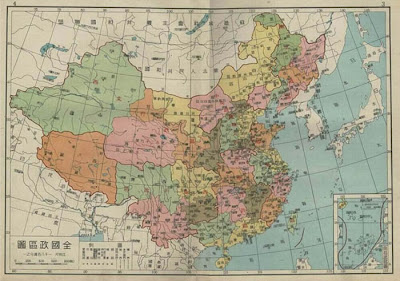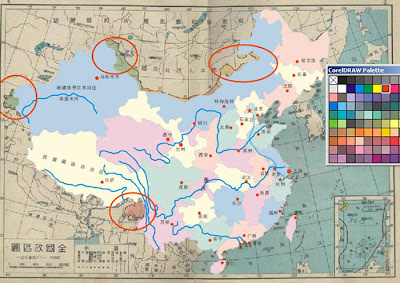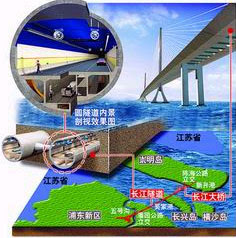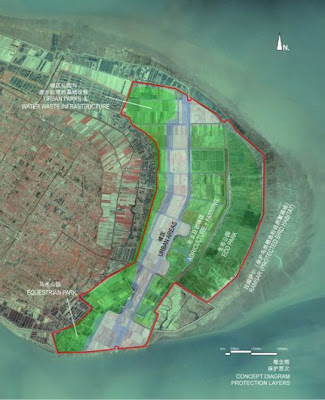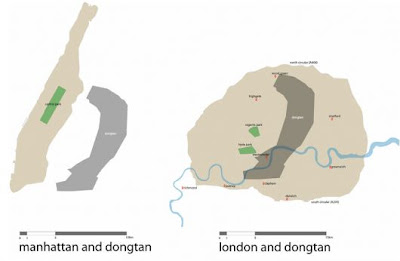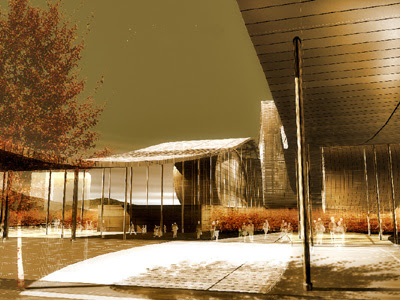UPDATE: My many thanks to ESWN for providing a great deal of corrections. Score another for CCWiki collaboration!
Ed. – This is my first attempt ever at translating something this long. I took alot of liberties and I’m sure I’ve made alot of mistakes, so I’m posting this as a working translation with the hopes that perhaps someone from ChineseContent who finds the story as interesting as I do will do a clean up. I was able to cross-check some facts thanks to Cross-Border Regional Management by Guo Rongxing, available in PDF here (pages 135-157 are on the Weishan Lake affair). There is also a map online of Shandong’s Weishan County, though the Jiangsu side doesn’t have placenames and I have yet to find the villages in question on the map). The original article from New World Weekly (新世纪周刊), dated July 28, 2006, can be found here.
In the previous post I outlined my interest in China’s provincial borders and how they only became legally binding in 2002. It gives some context as to why and how I chose this article. If anyone knows of any other provincial border disputes, please leave a comment or send me an email.
Also, I’m shocked that Blogger doesn’t have a built-in “read more” tag so I can shorten this post and it requires editing the template. That is pathetic.
Synopsis: Weishan Lake lies on the border between Shandong and Jiangsu province. In 1953, the national government transferred some villages from Jiangsu to Shandong’s jurisdiction. During dry seasons, the water recedes and opens up new land for cultivation. For fifty years, villagers in each province fought armed conflicts over the land. During the Cultural Revolution, the conflict reached a peak as villagers acquired military weapons and fought pitched battles. In the following decades, the villagers were still armed and there were periodically bloody clashes. As late as 2000, villagers were being shot and killed by their neighbors in a never-ending blood feud. Finally, in 2003, what appears to be a lasting peace has been reached.
微山湖畔边界械斗50年
The 50 Year Armed Conflict on the Banks of Weishan Lake
摘要:两个省因为边界划分械斗了50年,后来才发现解决问题似乎并不困难,很多人相信,只要政府措施得力,历 史的悲剧将不会重演
Summary: For 50 years two Chinese provinces have fought a bloody border dispute and finally reach a settlement. Many people believe as long as the government takes proper measures, a tragic history will not be repeated.
-特约记者/刘若南
Special Correspondent Liu Ruonan
卜庆堂已经找不到那叠厚厚的上访材料了,几年前,村民们还怀揣着它进京上访。“打了几十年官司,现在和谐了, 这些材料也没用了。”
Bo Qingtang couldn’t find the thick reams of petition material. Several years ago, villagers had carried it to Beijing. “The case went for decades, now there’s peace, so alot of it has become useless.”
卜庆堂曾经是山东省微山县大卜湾村的党支部书记,他见证了鲁(山东)苏(江苏)两省边界持续了半个世纪的械斗 ,并深深卷入其中。
Bo Qingtang was once the Communist Party secretary of Dabowan village in Weishan County, Shangdong province. He witnessed the 50 year armed conflict between Shangdong and Jiangsu province – and was deeply involved.
村民们称,在与隔湖相望的江苏省沛县丰乐村斗争激烈之时,对方曾放出话来,悬赏卜庆堂的人头。
Villagers say, during the fiercest time of the conflict with Fengle Village, in the Pei County of neighboring Jiangsu province, the other side offered a reward for Bo Qingtang’s head.
微山湖是中国北方第一大淡水湖,面积1266平方公里,它像一条狭长的玉带一样横亘在鲁苏的边界上,其东岸为 山东省微山县,西南岸为江苏省沛县和铜山县。
Weishan Lake is the largest freshwater lake in Northern China with an area of 1266 sq. km. It looks like a jade waistbelt spanning the Shandong-Jiangsu border, it’s east bank in Shandong’s Weishan County, it’s southwest bank in Jiangsu’s Pei and Tongshan Counties.
在微山湖畔,武力冲突曾经是一种常态。仅在大卜湾村,就有至少5人死于枪击。因为斗争的双方分别来自两个不同 的省份,而使问题的解决变得异常复杂,以至于相互间的厮杀一直延续到21世纪。据不完全统计,自1959年以来,湖区 边界共发生冲突几百次,数十人死亡,数百人受伤。
On the banks of Weishan, armed conflict was once the common attitude. Just in Dabowan Village, at least five people were shot to death. Since both sides are in neighboring provinces, and the difficulties of reaching a settlement became abnormally complex, they have been continually killing one another right into the 21st century. According to incomplete statistics, there have been hundreds of border clashes, leaving dozens dead and hundreds injured.
而如今,长期困扰中央和地方政府的微山湖边界矛盾,有了好转的趋势。今年6月,全国创建平安边界现场会议在微 山湖畔召开。之所以选在这里,是因为该地化干戈为玉帛的经验受到中央的高度评价,被认为是化解省界纠纷的典范。
Today, the long existing contradictions between the central and local governments policies regarding Weishan’s borders have been improving. In June 2006, a national border safety conference was convened in the Weishan area. Weishan was chosen because, should this “swords to ploughshares” experience receive the governments high approval, it was believed it could become a model for border dispute resolution.
解放后依然混乱的状态
After Liberation, Still a Chaotic Situation
微山湖畔的混乱状态,在国民党政府统治时期就很严重。“湖董、湖霸、地主把持湖面,盘剥欺压人民,他们为争种 湖田、争收湖产,愚弄群众进行械斗,纠纷层出不穷。”
In Weishan’s chaotic history, the period under Nationalist rule was extremely grave. “Lake rulers, Lake tyrants, landlords monopolized the area, exploited and bullied the people, they took the fields, stole resources, manipulated the masses to engage in armed conflict, one thing after another.”
1980年11月,时任微山县革命委员会副主任的杜忠仁在向国务院工作组所作的汇报中称,解放前微山湖被山东 、江苏两省8县分管,解放后因整个湖区领导仍未能统一,加上工作基础薄弱,群众纠纷与械斗仍不时发生。
In November of 1980, the then Weishan County Revolutionary Committee vice-chairperson Du Zhongren, in a report to the State Council, said that before Liberation the eight counties of the region were divided and since after Liberation they still were not unified, and they had a weak working relationship, the armed conflict would continue.
为了解决纠纷,经苏鲁两省协商,政务院批准,在1953年8月成立了微山县,隶属山东。中央批复和两省协议指 出:“湖区群众有纯以渔业为生的,有半渔、半农为业的,原则系将以上两种渔民村及湖中全部公田划归微山县”,“具体界 限,基本上以湖田为界,如以上划归微山县领导之村庄有突出于湖田以外者则以村庄为界”。1956年,国务院又在调整鲁 苏两省界线的批复中指出,“微山湖湖面,由山东省微山县统一管理”。
In order to settle the dispute, the two provinces agreed, with government approval, in August of 1953 the Weishan County was created as part of Shangdong. The two provinces, with the Central government, stated: “Some of the Lake region masses live completely off fishing, while others are half fishermen/half farmers. The principle is to allot the above two types of fishing village and all the public lands to Weishan county.” “The specific land boundary is basically defined by the lake lands. If a village that was allotted to Weishan county as described above should fall outside of the lake lands, then the village shall be the boundary.” In 1957, the State Council repeated this in a directive on the provincial boundary line: “The Weishan lake surface shall be administered solely by Weishan county, Shandong province.”
微山县的成立初衷,是为了更好地对微山湖进行统一领导,避免械斗。这种愿望在最初几年得到较好的实现,即使有 些矛盾,也能得到及时解决。但在1959年,中国实行“大跃进”战略之后,矛盾变得激烈起来。
In the beginning it was thought to be better for Weishan Lake to be under one leadership body to avoid armed conflict. For the first several years this seemed to be a successful, even if somewhat tense, and timely resolution. But in 1959, after China implemented the “Great Leap Forward” strategy, tensions flared.
因为雨量很少,这一年夏秋季节微山湖湖水已经大面积干涸,而湖田松软肥沃,是理想的庄稼种植地。位于微山湖西 侧靠近江苏沛县的地方大约有18万亩湖田,江苏沛县县委于是建立了抢种湖田指挥部,组织17处公社2万余人,1000 多头牲口,抢种了8.4万亩湖田。由此引发山东不满,双方械斗,打伤多人。
Due to poor rainfall, large areas of the lake dried up that summer harvest season, and the soil on the banks was soft, loose and fertile, ideal for growing crops. On the western shore near Jiangsu’s Pei County there were approximately 180,000 acres of lake fields. The residents of Pei quickly moved take the land, establishing 17 communes with nearly 20,000 people and over 1,000 livestock, grabbing roughly 8,400 acres of territory. This provoked the Shandong side, leading to a armed conflict that injured many.
在纠纷发生之初,江苏徐州地委对沛县的行为持支持态度,他们向江苏省省委强调,“过去沛县沿湖群众有种植湖田 的历史习惯”。不过他们很快为此做了检讨,江苏省委经过调查认为,“沛县县委应负完全责任”。
In this initial conflict, people from Xuzhou City in Jiangsu supported Pei County, emphasizing they are all Jiangsu people: “In the past the masses of Pei County have farmed the lake fields according to traditional custom”. However they soon issued a self-criticism, saying the people of Jiangsu had come to feel “The citizens of Pei County are solely responsible.”
文革前后,矛盾愈发激烈
During the Cultural Revolution, The Conflict Heats Up
1961年秋天,沛县提出“向大湖进军”的口号,重新组织力量,抢种微山湖湖田。引发纠纷后,山东和江苏两省 召开省、地、县三级协商会议,但历时50余天,矛盾未能解决。
In autumn of 1961, Pei County declared the slogan “Advance upon the Lake”, again gathered strength, and took control of Weishan’s lake fields. Another dispute erupted, and the two provinces convened a meeting of provincial, local and village officials. But 50 days later still no settlement had been reached.
这年冬天,江苏沛县国营湖西农场出动400多人,在湖田上种植庄稼,湖对面的微山县王楼大队认为,这片湖田是 他们所有,制止未果后,双方展开混战。王楼大队的村民用土枪将对方1人打死,将另1人打成重伤。
That winter, Pei County’s state-run farm sent out over 400 people to plant in the lake fields. Across the border a Weishan brigade(?), believing this was their land, confronted them and a clash ensued. The Wanglou brigade, armed with homemade guns, killed one and injured another.
此后,几乎每一年的种麦时节,双方都会发生械斗。据微山县杜忠仁1980年向国务院所作的汇报,1961年至 1966年,双方共发生械斗两百余起,1人死亡,百余人受伤。
Since then, nearly every planting season of the year, the two sides fought. According to Du Zhongren’s 1980 report, from 1961 to 1966, the two sides clashed over 200 times, leaving 1 dead and 100 injured.
1961年,刚刚结束的“大跃进”给当地经济造成重创,两岸村民也在“三年灾害”期间历尽磨难。解决饥饿问题 ,在很大程度上成为争夺湖田的一大诱因。
In 1961, right after the “Great Leap Forward” had inflicted heavy losses on the local economy, the villagers also suffered through the “Three Years of Natural Disasters”. The solution of the starvation problem was a huge temptation for the people to fight for the lake farmlands.
在微山湖边界的划分上,沛县乃至江苏省提出了新的主张。他们对于1953年的边界划分难以认同。
On the border issue, Pei County and even Jiangsu Province raised a new point: they refused to acknowledge the 1953 borders.
事实上,直到今天,接受采访的沛县村民在谈及此前的边界划分时,仍认为是对江苏的极大不公平,因为微山湖的资 源几乎全被划出了江苏,他们认为这是微山县和山东省“在中央有人”的缘故。一些村民仍然信奉这样的原则,湖水干涸后, 湖田是没有明确产权归属的无主之地,谁先抢种归谁。
The fact is, until today, in interviews about the border lines, Pei villagers said it was extremely unfair to Jiangsu, because Weishan County took practically all of its natural resources from them. They believed that Weishan county and Shangdong province have “connections” inside the central government. Some villagers still believe that after the lake dries, the lake fields don’t have clear property lines or owners, but rather follow a principle of “who grabs it gets it”.
此后,按照1967年4月27日周恩来总理的指示,南京军区政委杜平召集苏鲁两省及有关市、县和军队代表31 人,在南京举行了解决微山湖地区纠纷的专题协商会议。
Afterwards, according to instructions from Zhou Enlai dated April 27, 1967, Du Ping, Political Commissar of the Nanjing Army Command, with 31 representatives of the city, village and army, convened a special consultative conference in Nanjing to settle the dispute.
会议历时18天,“先以12天时间学习毛主席著作,解决思想问题,继以6天时间协商解决具体问题”。这次“革 命的会议”“揭发和批判了两省党内一小撮走资本主义道路的当权派对解决微山湖地区纠纷所设置的障碍”,并针对微山湖的 湖田纠纷达成4点协议。
The conference took 18 days, “For the first 12 days time they studied Mao Zedong and correct thought, and the remaining 6 days discussed specific details of a settlement”. This “Revolutionary Committee” “exposed and criticized the two provinces as following the capitalist road and ordered the Weishan region to establish a barrier”, and furthermore issued a four point conflict resolution protocol.
这次会议将部分权力下放给边界线自主协商,他们认为,通过“读毛主席的书、听毛主席的话,照毛主席的指示办事 ”,“发扬共产主义风格,顾全大局”,可以使问题得以解决。但南京会议预期的目的并没有达到。这在一定程度上是因为, 虽然仍坚持以微山县管理为主,但边界的划分还不如1953年清晰。
The factions could determine the borders and reach a settlement, they believed, by “reading the works of Mao Zedong, listening to Mao’s speeches, reflecting on Mao’s instructions”, “developing Communist thinking and taking the big picture into consideration”.* But the goals of the Nanjing meeting were never met. This certainly to some extent because Weishan County continued to administrate the region, but the borders remained unclear compared to 1953.
而“文革”的开始成为了问题没有解决的另一大原因。“文化大革命”正式发起的1966年,苏鲁边界两省村民共 发生武斗20起,伤60余人。
The problems of the Cultural Revolution became another obstacle to a settlement. In its inaugural year of 1966, the two provinces villagers clashed 20 times, injuring 60 people.
到了1967年,武斗逐渐升级,纠纷更加尖锐。1967年,江苏省沛县大屯和郝寨公社数百村民到邻近微山县的 薛城武装部抢夺枪支弹药,随后在微山部分村庄开始武装抢收庄稼。
In 1967, the conflict gradually escalated, the dispute became more pointed. Hundreds of villagers from Pei County Datun and Haozhai communes stole rifles and ammunition from the Xuecheng barracks in Weishan, began to rob the harvest by armed force.
“他们吹着冲击号打过来,很多村民都吓跑了,他们不仅抢收了庄稼,还将部分村民的羊、牛和船也抢跑了。”大卜 湾村的卜庆堂也记得邻近的王庄被洗劫的情形。因为之前中苏关系紧张,全民备战,中国各乡村都成立了民兵组织,而大卜湾 恰恰是当时傅村乡的一个枪点,拥有一挺机枪,十支步枪,所以大卜湾村未受侵扰。
“They charged over with the sound of bugle calls and many of the villagers fled in terror. They not only robbed the harvest, but they also took the sheep, cows and ships of some of the villagers.” Da Bowan villages’ Bo Qingtang remembers the neighboring Wang farm being looted at the time. Because the situation in China was tense, everyone had prepared for war and villages across China had set up militias, Dabowan happened to be one of the weapon storage depots in Fuchun town with one machine gun and ten rifles on hnad. therefore, Dabowan was not disturbed.
在这期间,微山湖畔的其他村庄也在为湖田、湖产而械斗不止。1973年9月,鲁苏两省在徐州开会协商解决湖区 纠纷,落实南京协议。为防止武斗,当时商定:凡有争议的地段,一律停止收割芦苇。
During this period, other villages on the banks of Weishan Lake also held armed fights over the lake farmlands and produces. In September 1973, the two provinces met again to negotiate a settlement, under the Nanjing protocol. To prevent further fighting, it was decided: all sides should stop harvesting reeds from the lake.
但这一协定在当年即未被遵守。仇恨越积越深,双方械斗之时,胜利者还在失败一方的村子中进行打、砸、抢、烧、 炸。1976年7月12日,微山县永胜等3个渔民村被江苏省铜山县马坡公社数百人洗劫,一座排灌站被炸毁,120余间 房屋被烧,150只水貂被烧死,渔民衣物也被抢光。
But many did not comply. There was too much deep hatred in both sides at the time, each side seeking to defeat the other village through attacks, assaults, raids, arson and bombings. By July 12, 1976, in Weishan County’s three villages together with the Mapo commune in Tongshan County, Jiangsu, there had been hundreds of lootings, an irrigation pump station had been blown up, over 120 homes are been burned down and 150 minks(??) had been burned to death, as well as the fishing folks belongings being looted.
械斗严重影响生产生活
The armed fights affected production activities severely
文革结束后,为制止双方械斗,政府部门采取了一些措施。微山县大卜湾村村民手中的子弹和枪支被县武装部收回。
At the end of the Cultural Revolution, government bureaus took steps to end the feud. The Dabowan villagers’ guns and ammunition were returned to the district military forces.
或许是村民并未全部上缴手中枪弹,在此后相当长的时间内,湖畔各村仍拥有数量不等的枪支弹药,在1979年9 月的一次械斗中,双方甚至动用了冲锋枪互射。
But perhaps they did not hand back all their weapons, because for a long time afterwards, the lake villages still varying amounts of guns and ammo. During a conflict in September of 1979, Both sides even shot at each other with sub-machine guns.
长期不止的械斗对冲突双方都是一场噩梦。1980年11月,微山县革命委员会副主任杜忠仁在向国务院工作组所 作的汇报中称,械斗“在政治上给党造成了极坏影响,在经济上给国家和群众造成了极大损失……由于纠纷不断发生,(山东 微山、江苏沛县、铜山)三县关系紧张,基层干部提心吊胆,不安心湖区工作,群众上访、告状常年不断,牵扯领导精力很大 ,由于纠纷的发展,水产资源遭到严重的破坏,鱼虾产量下降,湖产植物大面积减少,四湖建设规划不能落实,在解放30年 的今天,还有3万多渔民不能陆居,仍过着‘水上漂’的生活……”
For both sides the never-ending conflict was a nightmare. In November 1980, Weishan Political Committee Vice-Chairperson Du Zhongren, in his report to the State Council, said the dispute “Politically it had an extremely bad influence on the Party, economically it created enormous losses for the nation and the masses… because the conflict goes on, relations between the three counties (Weishan, Pei and Tongshan) are strained, low level cadres are scared and on edge, unable to work, the masses meet with higher authorities, petition straight through the whole year, taking up a tremendous amount of the leaderships energy. Due to the growth of the conflict, marine resources suffered critical damage, fish and shrimp output declined, vegetation around the lake has decreased, four construction plans cannot be implemented. Thirty years after Liberation, there are still 30,000 fisher folk without land to live on, still living a “floating” life…”
现在回顾起当年的械斗,微山湖两岸的村民和官员多认为,贫穷和收入来源单一是矛盾发生的一个主因。微山县是国 家级贫困县,大卜湾村原支部书记卜庆堂说,1980年代初,该村人均年收入不足100元。对岸沛县的丰乐村,人均也只 有几分耕地,干旱季节,抢种湖田或收割芦苇等湖产成为他们改善生活的重要途径。
Now looking back over the years of fighting, many of the two shores villagers and officials believe poverty and a single income source was the main cause of the clashes. Weishan is a national level impoverished county. Former Dabowan Party secretary Bo Qingtong says at the beginning of the 80s, annual per capita income didn’t reach 100 RMB. On the opposite bank in Fengle Village, Pei County, they also only had a few scraps of arable land. During the dry season, they would scramble to harvest reeds and other lake products to better their livelihoods.
1983年,山东省微山县大卜湾村村民成功进行了一次伏击,这次伏击导致江苏省沛县丰乐村村民1死2伤。
In 1983, the Dabowan villagers staged a successful ambush, this time killing 1 and injuring 2 Fengle villagers.
吴志宇是当时的受伤者之一。当时丰乐村在湖田上搭了窝棚,十几个人住在里面,日夜巡逻,以防大卜湾村村民前来 抢割。他记得出事的那天天气很热,他们傍晚时分在一片湖田上休息,东、南、北三方是茂密的芦苇。快到晚上6点的时候, 他们准备回去吃饭。吴志宇第一个站了起来。这时枪声响了,一颗来自东面的子弹射中他的右臂。紧接着,一个叫杜继夫的村 民当场被打死,还未结婚的20岁左右的青年王广华胸部中了3枪。
Wu Zhiyu was one of the injured. The Fengle villagers had built a shed, with 10 or so people on round the clock patrol, to defend against a Dabowan attack. He remembers the day of the incident the weather was very hot. As evening approached, they’d each stake out a section of the field. The east, south and north sides are dense with reeds. At 6 o’clock they prepared to return for supper. Wu Zhiyu was the first to stand up. Shots rang out and a bullet struck him in the right arm. Just after that, a villager named Du Jifu was killed, and an unmarried youth of about 20 years named Wang Guanghua was shot three times in the chest.
“打黑枪”事件引起轰动,根据中共中央和国务院的指示,“国务院赴微山湖工作组”于当年11月抵达现场进行调 查。工作组认为,以1953年的中央批复为基础,调整局部行政区划是必要的。
The “Black Guns” incident caused a sensation. According to the Central Communist Party and State Council directive, “State Council Working Group on Weishan Lake”, in November of that year an investigation began at the scene. The Working Group believed the 1953 committee had arrived at the right conclusion, that the administrative boundaries must be revised.
中共中央将这个报告批转给鲁苏及其他各省(市、自治区),并在批转通知中称,“对这一问题久拖不决,我们是有 责任的,江苏、山东两省也有责任”。
The Party sent a copy of this report to Jiangsu and Shandong as well as every province, along with the message “This problem has gone on too long. We are responsible, Jiangsu and Shandong are also responsible”.
一直到1985年秋季,民政部才在两省共识的基础上划分了大致的边界,但“具体划界及有关遗留问题的解决,由 两省自行协商办理”。为了更好地避免纠纷,国务院将原属江苏沛县的14个村庄划给了微山县。原定将沛县丰乐村等6个村 庄也一并划给微山县,但因为江苏方面的反对而作罢。
Throughout the autumn of 1985, the Ministry of Civil Affairs worked to build a consensus between the two regions on approximate borders, but “definite boundary lines remain a problem for a settlement, because the two provinces both want to do it their way”. To avoid more disputes, the State Council transferred 14 villages from Jiangsu’s Pei County to Weishan County. Originally Fengle was among 6 other villages to be transferred, but it was stopped by Jiangsu’s opposition.
微山方面认为,这主要是因为丰乐等村有丰富的矿产资源。这种说法在丰乐村也得到证实,先后两任村领导郭兆军和 蔡体夫均表示,江苏省原定在丰乐村筹建运煤码头,所以不同意划分给山东。但后来,这个码头并没有建起。
The Weishan side believes this was primarily because Fengle is rich in mineral resources. That kind of talk can also be found in Fengle. In succession two leaders, Guo Zhaojun and Cai Tifu both state, Jiangsu had already planned to build a coal transport dock there, so they disagreed on the boundaries with Shandong. But afterwards, the dock was never built.
在沛县其他14个村庄划给微山之后,因为有了统一的管理和分配,纠纷大大减少。而大卜湾村和丰乐村,却在此后 十余年内,不断发生血案。
In the other 14 villages now in Shandong, because of unified supervision and allocation, the dispute has diminished dramatically. Yet in Dabowan and Fengle, after ten years, the bloody incidents continued.
两个村庄的战争
The Two Village War
1980年代中后期,连续几年干旱。江苏省丰乐村和山东省大卜湾村各自在湖田上耕种庄稼,虽然仍时有冲突发生 ,但未酿成大的伤亡,两村村民在湖田上的耕地越来越接近,还出现了“交织田”(两村村民先后在同一块湖田上面耕种)。
In the late 80s, drought struck several years in a row. Fengle and Dabowan each plowed their crops in the fields. Although at this time the conflict was still going, it did not lead to major casualties. In the fields the two villages came closer and closer together, and there emerged “interwoven fields” (farmers from both villages sharing the same plot of land).
为了防止大规模械斗的发生,1990年6月初,在麦收即将开始之际,两地村领导喝酒谈判,商定共同行动,谁种 的谁收割,村干部在边界处维持秩序。
In order to prevent new outbreaks, at the beginning of June 1990 on the eve of the wheat harvest, the leaders of both villages drank wine, decided to work together, people shall only reap whatever they sowed, while cadres kept order on the borders.
在当年协商的一些细节上,现在双方仍存在不同的说法。丰乐村原村主任蔡体夫说,双方商定6月5日共同收割,但 大卜湾村村干部并未如约前来。大卜湾村原村支书卜庆堂说,当时双方还未确定具体时间,6月5日,丰乐村村干部单方带人 前往纠纷地抢割大卜湾村的麦田。大卜湾村百余人就带着“家伙”赶到了现场。
In recalling the details of the time, now both sides have different stories. Former head of Fengle Cai Tifu said the two sides agreed to harvest together on June 5, but the Dabawan cadres did not show up as arranged. Former Dabowan head Bo Qingtong says at the time the two sides did not set a specific date, June 5th, but Fengle cadres unilaterally decided to send people to the disputed territory to steal Dabowan fields. Over a hundred Dabowan villagers with “weapons” rushed to the scene.
在这场冲突中,丰乐村共有3人被枪击致死,其中1人是副支书王道伦,还有1名妇女孙西春。另有没来得及上船逃 跑的十余名丰乐村村民,也被打伤。在接下来的日子里,微山县政府部门途经丰乐村的车辆经常被村民扣留,有关人员受到殴 打。3名死者的尸体冷冻在殡仪馆中,一直到3年后才火化,死者家属数次前往北京上访,并曾酝酿抬尸进京。
In this battle, Fengle altogether had 3 shot dead, including vice-secretary Wang Daolun, as well as a woman named Sun Xichun. Another ten more villagers didn’t have time to escape to the boats, and were injured. In the days that followed, Weishan County officials detained Fengle drivers passing on the road, beating up people connected to the incident. The bodies of the three who died were frozen at the undertakers, only to be cremated three years later. The families of the deceased went to Beijing to petition and in the past considered taking the bodies with them.
公安部派人前往微山县调查此案,并和民政部研究重新划定湖界,但未能如愿。据微山县傅村乡原党委书记王洪彦介 绍,江苏省公安厅和山东省公安厅两名副厅长带队在大卜湾乡住了一个多月,最终也没调查出确凿的凶手,后来有3位嫌疑大 的村民被判两年有期徒刑。
The PSB sent a team to investigate these cases, and the Ministry of Civil Affairs once again conducted research on the lake boundaries, but could not succeed(?). According to Weishan’s Fucun village former Party secretary Wang Hongyan, the Jiangsu and Shandong police departments deputy heads together were in Dabowan over a month, but never definitively identified the murderers, but later on, three villagers who drew the highest suspicion were sentenced to two years in prison.
此后,丰乐村在湖田上建了一座了望塔,日夜有人在上面持枪巡逻。每到耕种和收获季节,两村村民都生活在恐惧中 。
After this, Fengle set up a watchtower in the fields with 24 hour armed lookouts. Come every tilling and harvesting time, both villages live in fear.
2000年,一场酝酿很久的报复行动开始了。这年春天的一个晚上,大卜湾村雇来挖鱼塘的一台价值100万元的 挖掘机被丰乐村村民烧毁,司机被枪击受伤。8月30日上午,63岁的村民卜庆元在湖田上自家的豆地里被人开枪打死。更 惨烈的杀戮发生在10月15日,大卜湾村的卜昭峰被枪击致死,来自山东滕州县的一对父子因受雇使用拖拉机在湖田里播种 ,也被拖到一边打死。死去的少年不满18岁,子弹从他头顶射入,脑浆涂地。
In 2000, discussion for a long-awaited retaliation began. One evening that spring, Fengle villagers torched a million RMB excavator hired by Dabowan to dig a fish pond, and the driver suffered gunshot wounds. On the morning of August 30, 63 year old Bo Qingyuan was shot and killed in his bean patch. On October 15, in a tragic massacre, Dabowan villager Bo Zhaofeng was shot and killed, coming from Shandong’s Tengzhou County with a pair of fathers (?) because mercenaries were using a tractor to sow seeds. He died before reaching his 18th birthday, a bullet to the head splattering his brains.
2003年的危机与转折
Crisis and Turning Point in 2003
在2003年,大卜湾村和丰乐村又面临一场严峻的危机。不过,在双方政府的努力下,械斗得以避免。
In 2003, Dabowan and Fengle were both faced with a grim crisis. But through the effort of the governments from both sides, armed fighting was averted.
卜庆堂说,2000年发生杀人事件时,宽达2500米的纠纷湖田中间尚有很多芦苇未被收割。此后,两村村民每 年都向中间扩展耕地,到2003年,中间的苇草已经全部被割掉,双方耕地连接在一起,又出现了“交织田”。这时双方都 意识到,大规模的械斗将再次发生。
Bo Qingtong says at the time of the murders of 2000, a wide 2500 meters in the center of the disputed fields still had many unharvested reeds. Afterwards, both villages every year expanded their territory, until in 2003 the center already completely shorn. The land of both sides now meets, and again appeared the “interwoven fields”. This time both sides are aware, a large scale conflict while once more erupt.
“这么多年械斗,村民都疲惫了,不愿再死人了。干部也害怕再出事。”微山县和沛县开始积极进行沟通,商定这一 年麦收实行错时收割,避免双方农民正面接触。在大卜湾村先行收割之后,丰乐村再开镰。
“There’s been so many years of fighting, the villagers are all exhausted, they’re not willing to accept another death. The cadres are also scared of an incident.” Weishan and Pei Counties have begun to renewed dialogue and are considering this years harvest being implemented at different times, so the farmers on both sides don’t have direct contact. Dabowan would finish their harvest first and then Fengle would begin their harvest.
麦收时,两地公安人员头戴钢盔、身穿防弹衣,手持枪支在纠纷地巡逻,以防出现纷争。这一年的危机成功度过。此 后,丰乐村单方面在纠纷湖田中部挖了一条1500米长、6米宽、2米深的生产界沟,作为两村的边界。这条界沟后来得到 微山县的默认。
At harvest time, the police of both sides wore steel helmets and bulletproof vests, and carry pistols while patrolling disputed areas, to prevent chaos and violence. This year the crisis passed. Afterwards, Fengle, on its own, dug a ditch in the center of the fields, 1500m long, 6m wide, 2m deep, creating a border. It later received Weishan County’s approval.
2004年8月,沛县与微山县缔结为友好县,双方约定,两县党政主要领导定期会晤。而山东省济宁市和江苏省徐 州市则签订了《关于联防联调共同维护边界地区社会稳定的协议》,并成立落实稳定协议的领导小组,互通信息,携手共建和 谐边界。
In August 2004, Pei and Weishan Counties entered friendly relations, with both sides agree to regular meetings between the two provinces major Party leaders. Both Jining, Shandong and Xuzhou, Jiangsu signed an “Agreement concerning the joint defense and accord to guarantee social stability in the border community area“, and furthermore set up a leadership group for the agreement to share information and work together for harmonious borders.
收缴枪支的行动也在微山湖畔雷厉风行地进行。两省公安机关建立了更广泛的合作,对涉及对方的犯罪事件进行打击 。湖畔的乡镇政府和村委会还组织村民,在邻省村民有困难时给予及时的帮助。大卜湾村村支书卜庆湘说,现在大卜湾和丰乐 两村村民常在湖中一起捕鱼,喝酒。
A weapons collection program by the Weishan lakeside area was carried out with great fanfare. The two provinces police forces have established closer cooperation in cracking down on crime. The lakes local governments have also organized to give timely assistance to neighboring villages in financial trouble. Dabowan village leader Bo Qingtong said now Dabowan and Fengle villager are often together fishing and drinking wine.
在得到一定赔偿之后,大卜湾村死于2000年的4具尸体在2005年春天被火化。疲惫的村民渴望安宁,政府部 门积极营造合作氛围,这被认为是2003年以后微山湖畔静悄悄的两个主要原因。
In spring 2005, the Dabowan victims of 2000 were cremated. The exhausted villagers wish for peace, the government is working to build a cooperative atmosphere, the feeling is post-2003 Weishan will be very quiet for these two main reasons.
“还有一个重要原因就是经济发展了。老百姓不会再像以前那样拼命争夺湖田、湖产了。他们有其他的收入渠道了。 ”沛县常委、宣传部部长刘广远说。
“One other reason is the economy has developed. The common people are unlikely to risk their lives fighting for the fields like they did before. Now they have other sources of income.” says Liu Guangyuan, head of Pei County’s Standing Committee and Publicity Bureau.






